Backblaze vs Dropbox
Despite reviewing and comparing countless cloud storage and online backup services, we rarely get to compare across the two categories. In this Backblaze vs Dropbox comparison, we’ll go through what each service can do and which is best for you.
There are two main reasons to upload files to the cloud — storage and backups. Normally, we would recommend using separate services, but that can get expensive. In this Backblaze vs Dropbox comparison, we’ll compare these cloud providers to see which you should prioritize.
Key Takeaways: Cloud Storage vs Online Backup
- Backblaze is a better value product for backing up lots of data on one device and has a longer file version history.
- Dropbox comes out ahead whenever you need to collaborate with others, sync files between devices or integrate third-party apps with your cloud storage.
- Neither has rock-solid privacy protections, but Backblaze is still better than Dropbox for user privacy.
When Dropbox was first released, it changed the cloud storage market in a big way. Now with over 17 million paying users, it’s still considered one of the biggest players in the field. If you’re looking for a collaboration-focused, feature-rich provider, Dropbox has some attractive offers.
On the other hand, Backblaze is a more traditional online backup. Rather than flashing fancy features around, it focuses on offering a cheap, secure and easy-to-use service. While it certainly has its flaws, we’ve considered it one of the best online backup providers for a long time.
-
04/11/2024
Updated to reflect changes in Icedrive’s pricing plans and storage offers.
How Did We Rate Backblaze and Dropbox?
We rated Backblaze and Dropbox by testing both services in real-world scenarios and looking through their privacy policies and security protocols. We also considered how much each services costs and how easy they are to use.
Backblaze specializes in being a low-cost, no-nonsense service. However, as we reveal in our full Backblaze review, its feature list suffers as a result. It also has some minor privacy flaws that we aren’t fans of.
Meanwhile, Dropbox completely drops the privacy ball, with no option for zero-knowledge encryption. It also doesn’t give you much storage space for the price, especially compared to Backblaze. However, our Dropbox review isn’t all bad news, as it also shows off how this cloud storage service aces file sync, sharing data and collaboration.
Dropbox vs Backblaze: Similarities & Differences
As we mentioned in the opening, online backup and cloud storage services are different enough that most providers focus on one or the other. However, at its core, you’re still uploading files to a distant server for long-term storage. This similarity means we can compare them.
| Features: | Dropbox | Backblaze |
|---|---|---|
| Continuous Backup | ||
| Incremental Backup | ||
| Unlimited Backup | ||
| Multi-Device Backup | ||
| Backup Scheduler | ||
| Block-Level File Sync | ||
| Zero-Knowledge | ||
| Mobile Backup | ||
| Versioning | 30 to 365 days | 30 to 365 days |
| Courier Recovery | ||
| File Syncing | ||
| File Sharing |
Similarities
Despite being so different, there are similarities between these services. These are the five major points where Dropbox and Backblaze take a similar approach to storing your files on the cloud.
Clean Interfaces
Although Backblaze easily takes the crown for ease of use (it’s basically one button and a small settings menu, after all), Dropbox isn’t exactly complicated or hard to understand. If you’re worried about whether or not you’ll be able to use a cloud backup service to the fullest, these are both great choices.
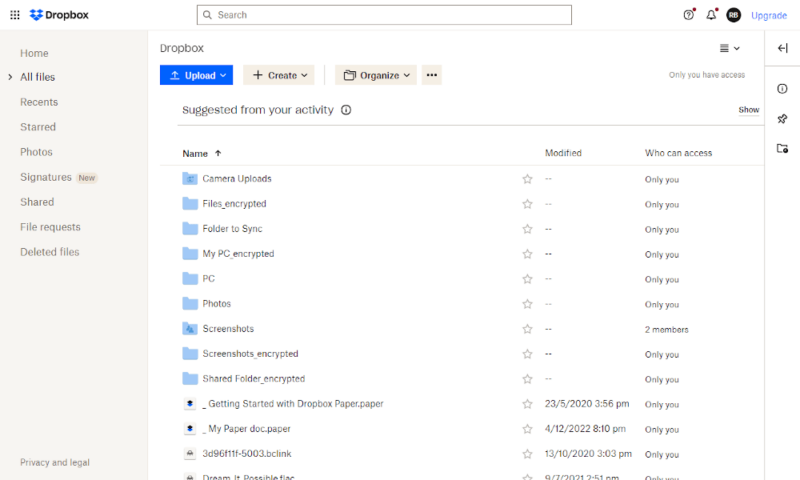
Continuous Incremental Backup
Although Backblaze has some basic backup scheduling options, both services use a continuous backup by default. This means that any time you change a file, the new data is automatically uploaded to your backup. This also gives you a more granular version control, as every modification effectively gets its own entry.
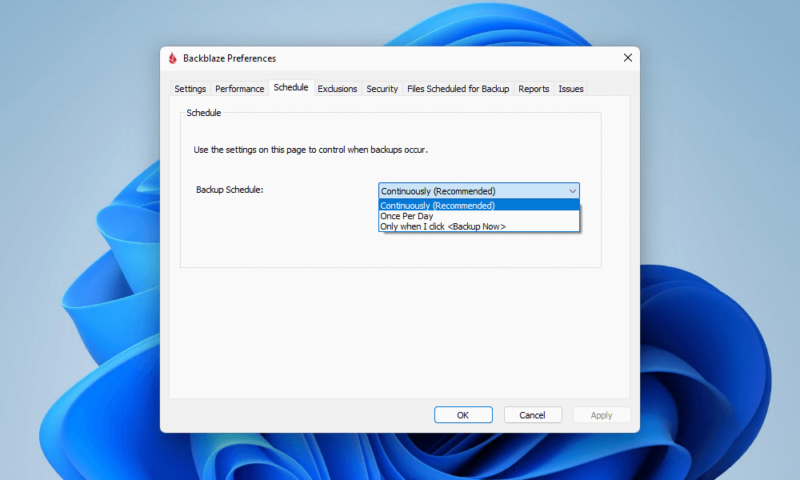
Since a full backup of all of your files can take a long time, both services also use an incremental backup. This means that you only have to upload files that have changed since the last backup, rather than everything.
Block-Level File Transfer
One downside to a continuous backup is that small changes to a big file will require the entire file to be uploaded. This can flood your internet bandwidth and slow down your computer. Even worse, it can block other modified files and documents from being backed up for a long time. This issue is worse with slower connections.
However, there is a solution that both Backblaze and Dropbox include by default with all plans — block-level file sync. Rather than uploading entire files, the service breaks them down into small “blocks” of data, then only uploads the ones that have changed.
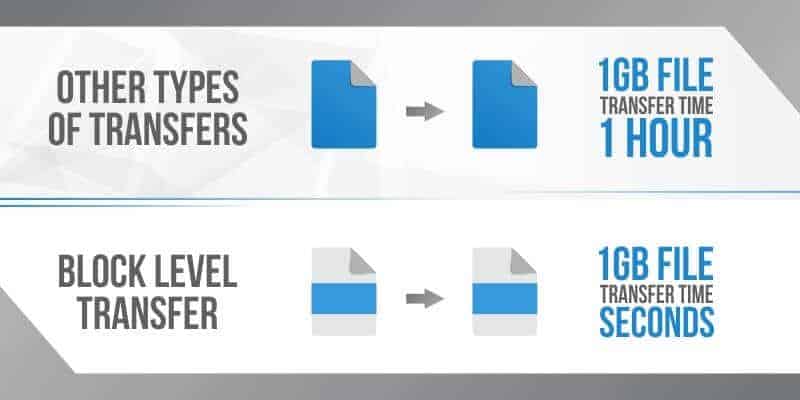
Note that some have claimed that block-level sync and zero-knowledge encryption are mutually exclusive, because the encryption scrambles the entire file when a small part is changed. Although this is technically true, it’s still possible to have both by breaking files into blocks before they’re encrypted.
Business Backup
Although we’re focusing on the personal backup and cloud storage options from both providers, it’s worth noting that they also offer solid business plans. Backblaze B2 cloud storage service gets frequently selected in many of our cloud computing reviews, whereas the Dropbox Business plans get it into the top five best business cloud storage services.
Disappointing Privacy & Security
Dropbox has U.S.-based data centers and, despite the Boxcyptor acquisition, it still lacks zero-knowledge encryption. This means your data is just one court subpoena away from being handed over to the government. Even worse is that Dropbox’s privacy policy states that any of your data can be shared with “trusted third parties” — including Google and Amazon.
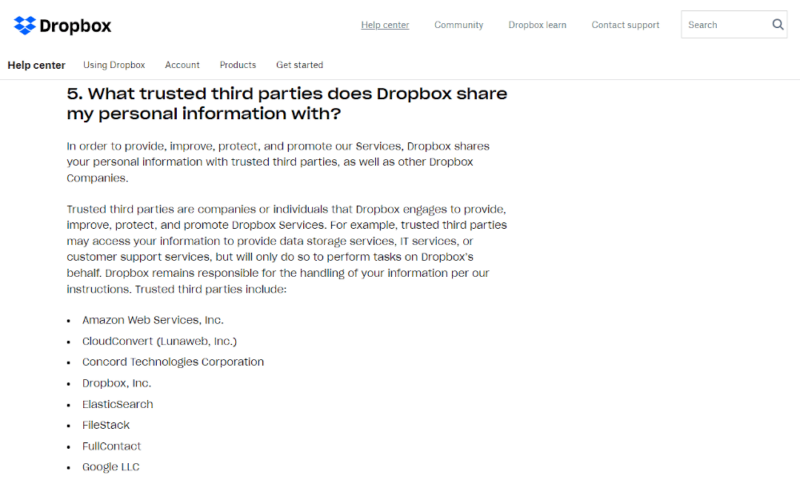
Backblaze is much better here, as it attempts to use zero-knowledge encryption to prevent this. However, if you need to recover your data, you have to hand over your private key through the web client. The second you do this, you’re trusting Backblaze to delete it. This simply isn’t good enough from a privacy perspective. SpiderOak triumphs in this aspect against both Backblaze and Dropbox. You can find more info in our SpiderOak vs Dropbox guide.
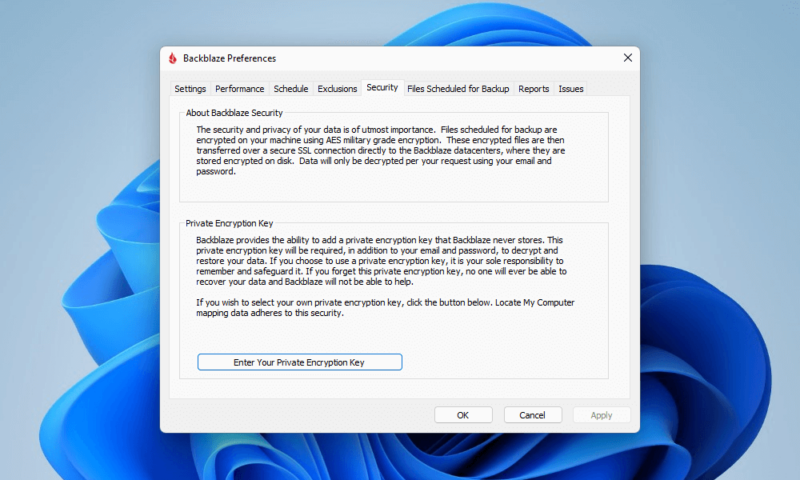
Differences
Now we’ve gone through the handful of similarities between these services, we need to look at the differences. There are a lot more of these, so try to stick with us. However, you can always jump to headings that interest you.
Unlimited Backup
Like most personal cloud storage services, a Dropbox subscription comes with a limit. The Plus plan limits you to 2TB and the Professional plan limits you to . However, Backblaze is an unlimited backup provider, and will happily store as many terabytes (or even, theoretically, petabytes) you’re willing to upload to it.
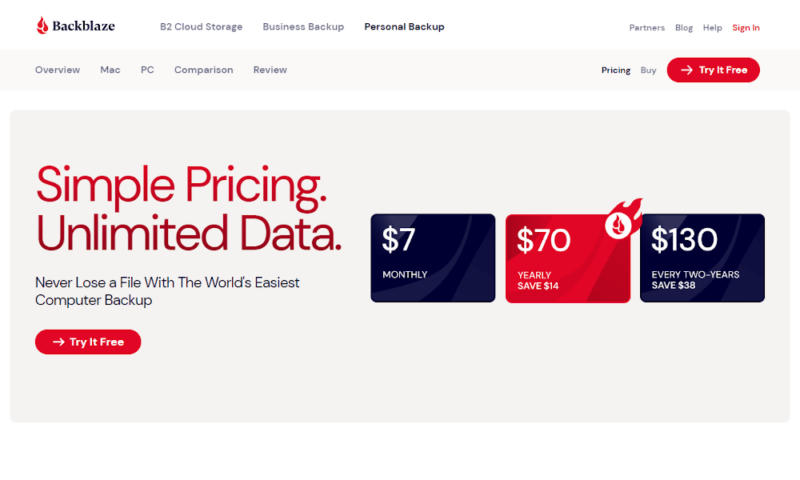
Multiple Device Support
The major drawback to Backblaze’s all-you-can-eat approach to storage is that you can back up only one device at a time. A Dropbox account can hold data from as many devices as you want, as long as all your data fits within the storage space limits.
Not only does Dropbox let you store files from multiple computers, but it also has apps for a wider range of devices. While both providers support Mac and Windows PC, Dropbox also has native apps for both Android and iOS devices.
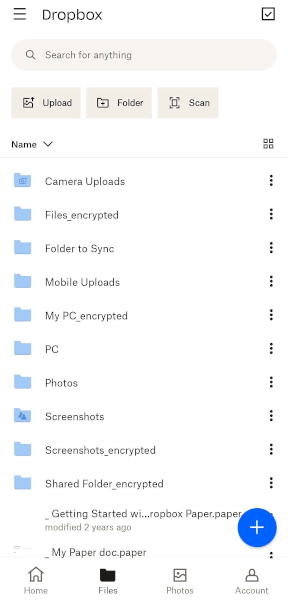
Linux users should look elsewhere for a proper cloud storage for Linux. However, Dropbox at least has a competent web-based UI, in case you want to access data saved through the other apps or move a few files to the cloud. Backblaze’s web client is basically only there to recover files.
File Synchronization & Sharing
One benefit of working across multiple devices is that you can sync files between them. When syncing files, Dropbox even lets you choose whether to keep them hidden, online-only or downloaded on a per-device and per-file basis with the selective sync tool. Backblaze limits you to one device and has no such feature.
Backblaze does have a sharing feature, but it’s very simplistic and costs extra money. If you want to share files, then you’re better off with a proper cloud storage. Dropbox makes sharing files so astonishingly easy that it makes it onto our top cloud storage for collaboration list.
Continuing the trend of Dropbox having great file-sharing and collaboration features is Dropbox Transfer. This is a decent extra you get alongside Dropbox that lets you send files to other people, even if they don’t have a Dropbox account.
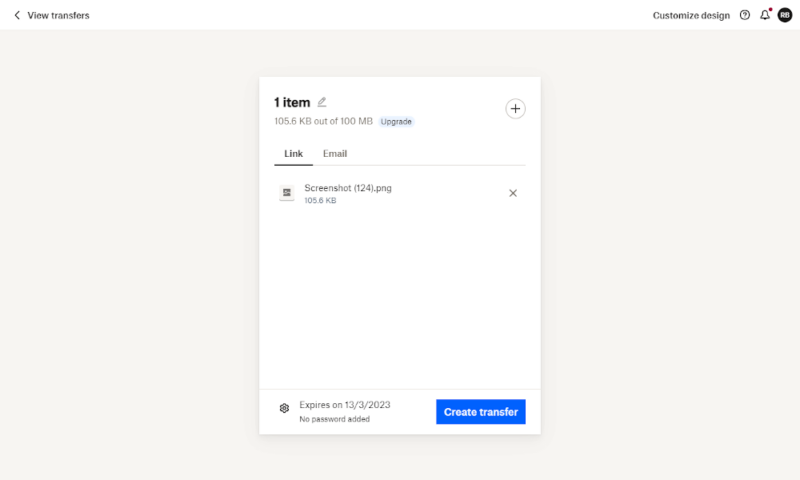
This is a secure and user-friendly way to share files with anyone. You get unlimited 100MB transfers allowed on the free plan, which increases to 100GB transfers on certain paid plans. You can learn more in our article on how to share files in Dropbox.
Backup Contents
While Backblaze won’t back up everything on your computer, it only leaves out folders that you specifically block and any temporary or operating systems files it finds. Dropbox Backup makes you manually add everything to your backup. This is an annoying task and there’s a risk you might miss something important.
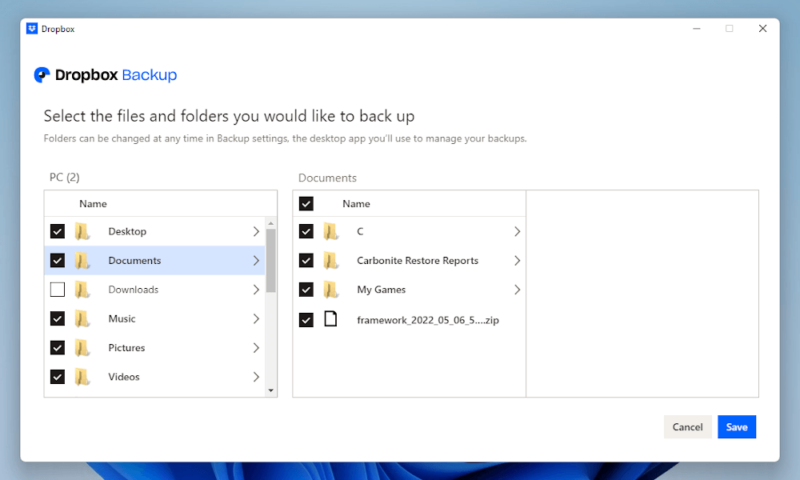
High Speed & Courier Backup
Dropbox isn’t the fastest cloud storage, but it sits firmly in the top five. This is leagues ahead of Backblaze, one of the slowest online backup services. Granted, Backblaze has decent download speeds, but the poor upload speed will be a problem for many.
However, even the fastest backup can take days or even weeks to upload or recover from, if it’s large enough. That’s why some providers offer a courier delivery service for your backup.
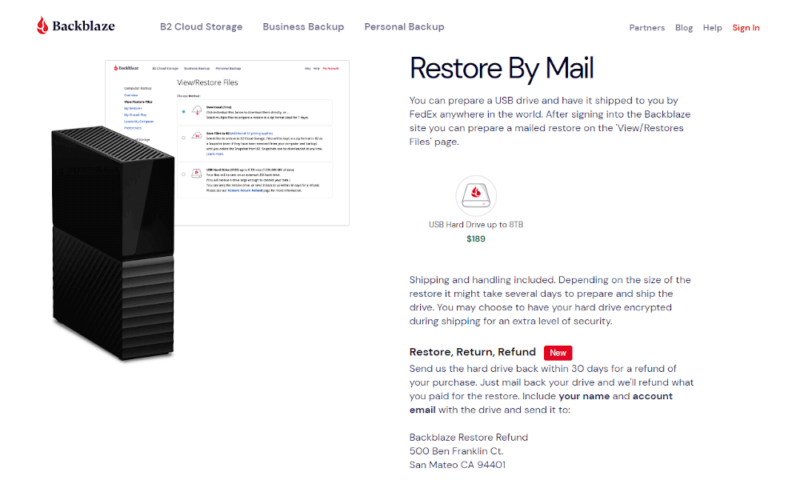
Dropbox doesn’t offer courier delivery service, but Backblaze does. Each download costs $189, but you can return the drive for a full refund up to five times a year.
Backblaze also offers courier uploads, called “fireball,” but it is available for only Backblaze B2 customers and at an eye-watering $550 for the 30-day rental fee plus $75 for shipping. It’s clearly aimed at businesses, but at least the option is there.
File Versioning
Both services offer a 30-day file history by default, but the versioning with Backblaze is more expandable. Dropbox increases that to only a 180-day history when you upgrade to a Professional or Standard Business plan (365 days on the Advanced Business plan), whereas Backblaze offers a full year for just an extra $2 per month.
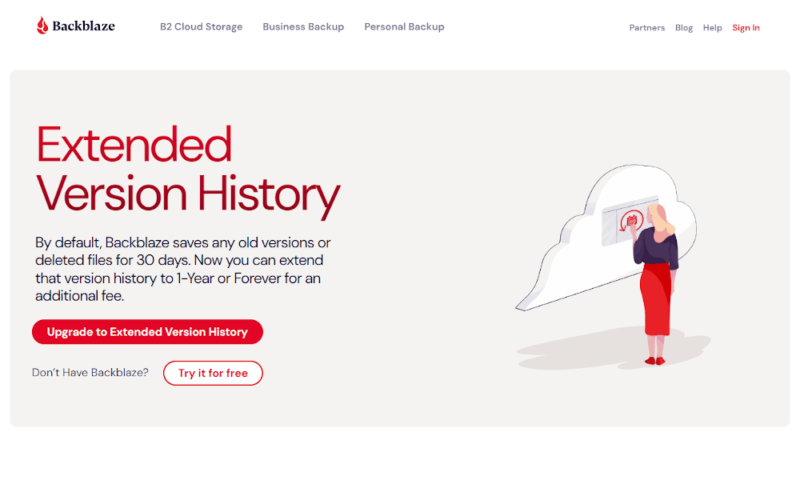
Pricing
Although a lot of the comparisons here tend to favor Dropbox, it’s worth considering that Backblaze costs just over half as much. When paying annually, the Dropbox Plus plan is $9.99 per month, while Backblaze costs just $8.25 per month.
Those extra dollars could be used to buy a cheaper cloud storage plan, like Icedrive’s Lite plan for $2.99 per month (two-year plan) (read our Icedrive review). That way, you still get some cloud storage to play with, while protecting your main computer with an unlimited backup.
- 1 user
- 2GB
- 1 user
- 2TB
- up to 6 users
- 2TB
More plans
- (Formerly Dropbox One) 1 user Signature requests and eSignature templates
- 3TB
- 3 users minimum
- 5TB
- 3 users minimum
Which Is Better: Backblaze vs Dropbox?
Backblaze is a better backup service than Dropbox, but it lacks the flexibility to be used as a cloud storage service. Ultimately, when dealing with two services that are this different, there’s no one definitive answer to “which is better.” However, there are certain cases where you would want to choose one over the other.
We Recommend Backblaze If You Want…
- Unlimited Backup: A single device backup without storage limits
- Great Value: The most bang for your buck when backing up a single device
- Long-term File Versioning: Up to a year of recovery for deleted files
We Recommend Dropbox If You Want…
- Multiple Devices: To access your storage from any device
- Sync & Share: A great choice for cloud storage features like file syncing
- Speed: Fast and reliable transfer speeds
The Verdict: Why We Think Backblaze Wins Overall
Picking a single winner here is difficult. If you’re looking for a solid, single-device backup, it’s clear that Backblaze is the better choice. However, if you need any cloud storage tools alongside your backup, or the ability to back up mobile devices, we suggest you choose Dropbox.
However, the difference in price is enough to get one of the best cloud storage services. Therefore, if you’re looking for the best of both worlds, we recommend you grab Backblaze and use the leftover cash for a better cloud service.
Just bear in mind that Dropbox and Dropbox Business are geared toward different users. Read our full Dropbox vs Dropbox Business guide to learn more.
Do you agree with this? Have you used a cloud backup service before? Do you think either Backblaze or Dropbox is worth using? Let us know your thoughts in the comments below. Thanks for reading.
- 1
- :
- :
- :
- :
- 2
- :
- :
- :
- :
- 3
- 4
- 5
- :
- :
- :
- :
FAQ
Backblaze is mainly for backing up a single computer, whereas Dropbox focuses on syncing and sharing files across multiple computers.
Although it depends on your specific requirements, we think that IDrive is a better backup option than Backblaze overall.
Backblaze is cheap because it charges you based on what an average user stores. This means that if an average user stores just 100GB, that’s all they’ll charge you for — even if you’ve backed up hundreds of terabytes.



